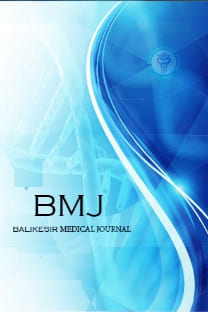Birinci trimester fetal baş popo mesafesi ile doğum ağırlığı arasındaki ilişki
CRL, Anormal doğum ağırlığı, Düşük doğum ağırlığı, İlk trimester
Relationship between first trimester fetal crown-rump length and birth weight
Crown-Rump Length, newborn birth weight, perinatal outcomes,
___
- 1- Gluckman PD, Liggins GC. Regulation of Fetal Growth. In: Beard RW, Nathanielsz PW, editors. Fetal Physiology and Medicine: The Basis of Perinatology. 2nd ed.New York: M. Dekker; 1984. p. 511-58.
- 2- Smith GC. First trimester origins of fetal growth impairment. Semin Perinatol 2004;28(1):41-50.
- 3- Smith GC, Smith MF, McNay MB, et al. First-trimester growth and the risk of low birth weight. N Engl J Med 1998;339:1817–22.
- 4- Bukowski R, Smith GC, Malone FD, et al. Fetal growth in early pregnancy and risk of delivering low birth weight infant: prospective cohort study. Br Med J 2007;334:836.
- 5- Leung T, Sahota DS, Chan LW, et al. Prediction of birth weight by fetal crown–rump length and maternal serum levels of pregnancy-associated plasma protein-A in the first trimester. Ultrasound Obstet Gynecol 2008;31:10–4.
- 6- Pedersen N, Figueras F, Wojdemann K,et al. Early fetal size and growth as predictors of adverse outcome. Obstet Gynecol 2008;112:765–71.
- 7- Olson IE, Groveman SA, Lawson ML, et al. New intrauterine growth curves based on United States data. Pediatrics 2010;125:e214-24.
- 8- Buck G, Cookfair DL, Michalek AM, et al. Intrauterine growth retardation and risk of sudden infant death syndrome (SIDS). Am J Epidemiol 1989;129:874–84.
- 9- Barker D, Martyn C. The maternal and fetal origins of cardiovascular disease. J Epidemiol Community Health 1992;46:8–11.
- 10- Baschat AA. Fetal growth restriction – from observation to intervention. J Perinat Med 2010;38:239–46.
- 11- Balcazar H, Haas J. Classification schemes of small-for-gestational age and type of intrauterine growth retardation and its implications to early neonatal mortality. Early Hum Dev 1990;24:219–30.
- 12- Kurtoğlu S, Akın MA, Sarıcı D. İntrauterin büyüme: Prenatal ve postnatal değerlendirilmesi. Turk Aile Hek Derg 2011;15(3):91-100.
- 13- Hadlock FP, Shah YP, Kanon DJ, et al. Fetal crown-rump length: reevaluation of relation to menstrual age (5–18 weeks) with highresolution real-time US. Radiology 1992;182:501–5.
- 14- Lawrence EJ. Part 1: a matter of size: evaluating the growth restricted neonate. Adv Neonatal Care 2006;6:313–22.
- 15- Miller HC, Hassanein K. Diagnosis of impaired fetal growth in newborn infants. Pediatrics 1971;48: 511-22.
- 16- Türkmen M, Aydoğan F, İnan G, et al. Aydın’da zamanında ve prematüre doğan bebeklerin ağırlık, boy, baş çevresi ölçümleri ve ponderal indeksleri. ADÜ Tıp Fakültesi Dergisi 2000;1:17-22
- 17- Jae-Yul Kang, Eun-Ju Park, Yun-Suk Yang, et al. Crown-Rump Length Measured in the Early First Trimester as a Predictor of Low Birth Weight. Yonsei Med J. 2013;54:1049–1052.
- 18- Pardo J, Peled Y, Yogev Y, et al. Association of Crown-Rump Length at 11 to 14 Weeks’ Gestation and Risk of a Large-for-Gestational-Age NeonateJ Ultrasound Med 2010;29:1315–1319
- 19- Thorsell M, Kaijser M, Almström H, et al. Large fetal size in early pregnancy associated with macrosomia. Ultrasound Obstet Gynecol 2010;35:390–394.
- 20- Salomon LJ, Hourrier S, Fanchin R, et al. Is first trimester crown-rump length associated with birthweight? BJOG 2011;118:1223–1228.
- 21- Ustunyurt E, Simsek H, Korkmaz B, et al. First-trimester crown-rump length affects birth size symmetrically J Matern Fetal Neonatal Med, 2015; 28(17): 2070–2073
- 22- Vafaei H, Samsami A, Zolghadri J, et al. Correlation of first-trimester fetal crown-rump length with outcome of pregnancy and birth weight. Int J Gynaecol Obstet. 2012 Nov;119(2):141-4.
- 23- Mook-Kanamori D, Steegers EA, Eilers PH, et al. Risk factors and outcomes associated with first-trimester fetal growth restriction. JAMA 2010;303:527–34.
- Yayın Aralığı: Yıllık
- Başlangıç: 2017
- Yayıncı: Balıkesir Üniversitesi
Şule ÖZEL, Serkan BODUR, Yaprak ENGİN-ÜSTÜN
Fitzpatrik’in Ritim Kuramına Göre Mide Malign Neoplazmı Olan Hastanın Hemşirelik Bakımı: Olgu Sunumu
Ayşe SERPİCİ, Birsel Canan DEMİRBAĞ
Serdar HIRA, Hatice Gülşah KARATAŞ, İsmail HASKUL, Ramazan GÜNDÜZ, Betül ÜSTÜN, Müfit AKYÜZ
Eritema Nodozum Tanısı almış Pediatrik Hastaların Değerlendirilmesi: 6 Yıllık Deneyim
Mehmet KÜÇÜK, Demet CAN, Murat HIZARCIOĞLU
HIV/AIDS Hastalarında ELİSA Yöntemi İle Cryptosporidium Türlerinin Sıklığının Araştırılması
SELEKTİF OTOFAJİ VE ALT TİPLERİ
Birinci trimester fetal baş popo mesafesi ile doğum ağırlığı arasındaki ilişki
Çiğdem Yayla Abide, Ebru Çöğendez, Pınar Kumru, Murat Keskin, Evrim Bostancı Ergen, Çetin Kılıççı
Çölyak hastalığı ile komplike nadir görülen otoimmün poliglandüler sendrom; tip3B
Hakan Aydın, Zülfükar Bilge, Abdullah Algın, Hüseyin Avni Fındıklı, Bünyamin Aydın
